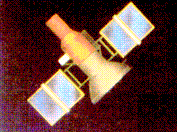
SIGMA - GRANAT
Centre d'Etude Spatiale
des Rayonnements
Département
Hautes-Energies
The SIGMA modes of observation
==============================
Several modes of observation can be used with the telescope:
* The spectral-imaging mode is the most frequently used mode of observation.
The average acquisition time for a session is 24 hours.
The following data are recorded simultaneously :
** Fine images with 1.6 arc-minute resolution (248 x 232 pixels) in four consecutive
programmable energy bands.
** Spectral images (124 x 116 pixels) through the entire energy domain in
95 energy bands varying logarithmically in width.
** A spectral analysis for all the photons detected in the position detector.
** Slow variability data : the photon count is recorded every four seconds
in the four same consecutive programmable energy bands as the fine images.
** Attitude of the telescope every four seconds.
** When a burst trigger is sent :
*** Images of bursts are made by the detector.
*** A temporal and spectral analysis can be made of the bursts
by anticoïncidence counters placed around the telescope.
* During the variability-imaging mode, the spectral images in the 95 energy
bands are replaced by 48 consecutive time images obtained in a programmable energy band.
* The photon-photon mode is measuring the position and the energy of all the
photons which enter the detector area. Each 63rd photon is dated in milliseconds.
* In the fast-variability mode, the energy and date in milliseconds of each
photon detected is calculated without spatial information.
Data transmission
~~~~~~~~~~~~~~~~~
SIGMA data are downlinked about every 24 hours to the ground station in
Evpatoria in Crimea during the part of the orbit during which the
payload operates.
Every month, a French scientist team is present to receive data from SIGMA and
do operational data control.
Then SIGMA data are taken back in France to be processed and analysed.





